How to Start Jumping
Steph,
Yesterday I saw one of your solo climbs on Youtube. I never imagined that It was super easy to find your blog/email online. To me that says that you are connected with the people you motivate. I think it is rad that you are sharing your climbing and base jumping experiences. That’s what its all about.
My name is Jason and I started climbing a year ago. I learned to lead by going to local crags and talking with other climbers. Soon, I started slackening than thru hiking.
Anyway, I am now interested in base jumping. I dont have a lot of cash and I dont want to go out and jump next week. I just want to learn from people who are great and soon understand how the system works. Where do you think the best place to do this is? (I am moving to UT in a few weeks… I am stoked 🙂 ) Unlike climbing, I am unfamiliar with how to go about learning all of this info. Thanks for having a cool blog where you can be reached.
Jason Flaster
Steph,
I have never had any skydive lessons or anything but base jumping is something that iv always wanted to do. what is the best way to get into it? how much £££ would i be looking at spending?
Chris
Hey There!
Im a young guy from Kentucky, looking to find the next big adventure in my life! I’ve been wanting to sky-dive for the longest time, just dont know where to start.
There are a few small companies close to Kentucky, but im looking for something somewhere else. I understand it requires alot of training to become a base-jumper, but i need to know exactly what that consists of. Just seeing if u had any info for me! Thanks Alot!!
Wade
Hey Steph,
Thank you for responding to my email a while back in regards to training during time off from climbing. I’ve fortunately been able to climb a lot recently but plan on using your tips once trail season starts up this summer.
I have another question for you not related to climbing but to skydiving/BASE jumping. My boyfriend is an avid skydiver and has been trying to convince me to get my AFF for a while now. I’ve done a few tandems and enjoyed them but I am reluctant to start jumping because of the financial and time commitments it entails. I was curious as to how you first got into skydiving and how you progressed into BASE jumping and wingsuit flying. How has the sport continued to inspire you and what advice would you give someone like me considering entering the sport? Also, do you find many parallels between climbing and jumping?
Thanks,
Adra
Dear Steph,
My name is nate, I’m 26, and I’ve had a rather crazy life. However it seems that the things I love to do and the things that I long to do are always just outside my grasp. I love to climb, and got started in Hawaii, but I live in Mississippi now and have no where to climb, and little spare time to do so. I want to sky dive badly, but the cost keeps me on the ground. I dream of one day being able to climb whenever I want, and to BASE jump into free air… with no worries. I must confess that I stumbled on to your email through the website high infatuation while searching information on BASE jumping, but I feel like we have spoken. I read an article of yours… it was a few years ago, possibly in Alpinist, or maybe Rock and Ice, where you spoke of free climbing in Rifle I believe? I may be mixed a bit on the details, but I loved the article, and it inspired me to find the confidence you have in yourself. I can’t say I’m there yet, but I am in no hurry to live really. I have seen a lot for my years, and I can say I am lucky to be alive. I have survived a few vehicle accidents that some of my friends did not. I also was an infantry marine during the assault on fallujah in iraq. Oh well. I already feel like I’m blowing smoke up your backside so here’s to climbing and here’s to jumping, and thank you steph davis for writing your article that I was so happy to read, and have been overjoyed to reread and recommend to climbing friends. I hope you live a long and happy life doing the things I wish I could be doing. You are in a sense a model for what I would like to be in my future. Thank you again for the inspiration… and sorry again for hitting the tab button and sending this ridiculous email.. my girlfriend warns me about the tab button and I laugh… she’s laughing now.. ha.. Salut!
Nate C.
Hello Steph,
My name is Payal. I am writing because I LOVE to travel but I would like to try my hand at a few more adventures like sky diving, base jumping. I am starting training to start summiting etc… By the time I am 30 I want to base jump in the cave of swallows. I have read that 30 base jumps are recommended before the cave of swallows and between 100-200 sky dives are recommended before base jumping. Is this correct? I don’t make a lot and so I am hoping to ask you for some practical advice on how to go about doing this. I am 28 and I turn 30 in Nov 2011.
Thanks!
Payal
Hi All!
Thanks for writing me! The more letters I get from athletes who want to start base jumping, the more I get literally furious that that the best and safest cliffs in America are illegal for base jumping, due to being inconveniently located in National Parks.
Please, think seriously about the meaning of this restriction of freedom for outdoor enthusiasts. Our generation has to ask why one low-impact user group, causing no one harm, is targeted for persecution and prevented from enjoying public lands which are maintained by our tax dollars.
So in one way, it’s difficult to answer these questions about how to start base jumping, because the correct and safe progression would be to start skydiving, then learn at a bridge, and then eventually to visit Yosemite, and make your first cliff jumps from El Capitan. El Cap is the safest and most appropriate beginner cliff in America. However, the artificial constraints of illegality make the jump more serious, since running from rangers to avoid being charged with a federal offense and having one’s expensive gear stolen by them adds to the danger of the jump. So instead, a new base jumper has to make the difficult decision to start by jumping lower, more dangerous, yet legal cliffs, or travel to Europe, spending lots of money that will go to into Europe’s economy rather than ours. Last time I checked, the US economy should be doing anything possible to direct any dollars, tourist or otherwise, into our own rather than anyone else’s. Aside of all that, if you refer to the NPS mission statement, like me you will be thinking, “Excuse my French, but WHAT THE F$%#, NPS?”
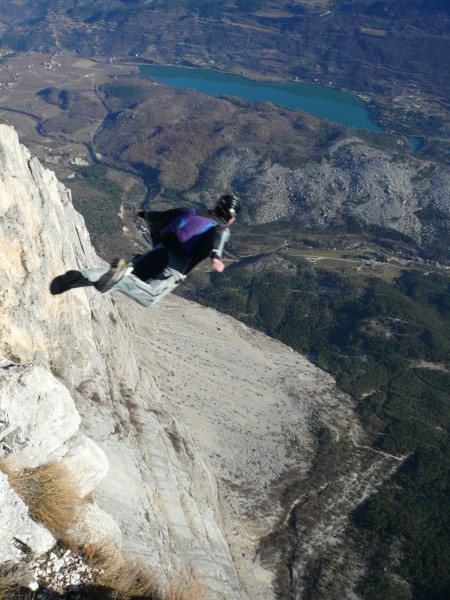
So anyway, let’s back up a little. How to start base jumping. Regardless of this ludicrous situation with our National Parks, base jumping must begin with skydiving. The good news is that skydiving is legal and accepted everywhere, and is in fact, quite mainstream.
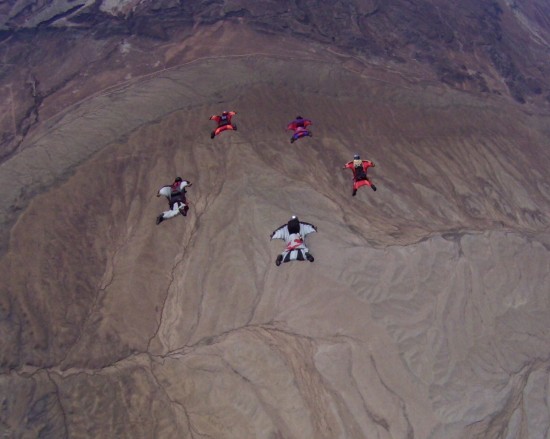
Not to mention, awesome! Personally, I love skydiving as much or more than base jumping. I live in Moab, a mecca for legal base jumping, and I will almost always pick skydiving over base jumping when presented with both in a given day here.
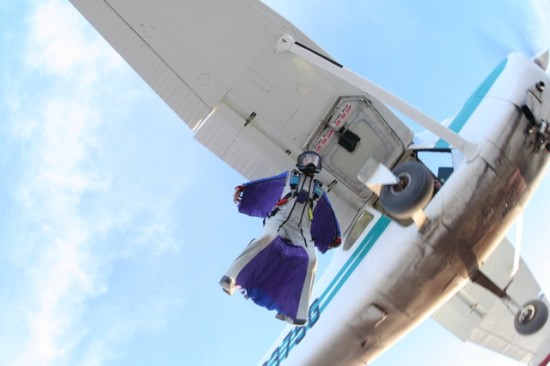
Here is what I recommend to anyone interested in base jumping: forget about base jumping. This is about the journey, not the end. Immerse yourself in skydiving, which is awesome in itself. If you could do 1000 skydives, you would probably save yourself some hospital bills when you started base jumping. Most people are not willing to do 1000 skydives before starting to base jump, if base jumping is their desire.
I was one of those people, and I started base jumping when I had done 130 skydives, which is really not enough. Looking back, I might have avoided most of my early base injuries (in the first year of base), and therefore spent less money, had I invested in 1000 skydives proactively, rather than spending that money on medical bills and time-outs through being injured when landing base canopies. I have gotten hurt several times crashing when landing, though I have been fortunate in having minor and fully recoverable injuries. I have seen tons of people with low skills avoiding accidents completely through sheer luck. Sometimes this makes people think it’s okay to count on “getting away with it,” rather than investing the time to build skills through hard work and experience. And weirdly enough, a lot of people do get away with it in base jumping, through sheer inexplicable luck, for a really long time. On the other hand, plenty of people don’t. You can’t know which you will be. The thing about luck, is you can’t predict anything about it. You can be ridiculously lucky, or not. Personally, I think it’s smart to plan for not being lucky by investing in skill. I’d rather gamble on skill and experience than luck, no matter how many other people I see “getting away with it.”
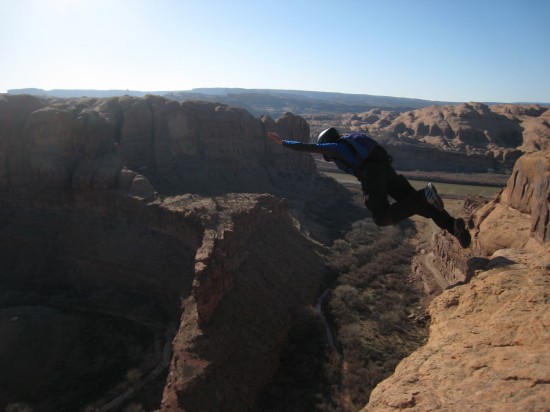
The thing is, the majority of accidents and injuries are going to occur when landing parachutes, particularly for athletes who are familiar with learning how to position their bodies (climbers), since we are naturally more adept at free fall and body positioning due to our experience with climbing. This can keep you from having wall strikes and accidents due to body position. However, landing parachutes, like landing airplanes, is a skill that can only be acquired through experience. Bottom line: when you first start landing parachutes, you will not be good at it. Skydiving gives you an entire flat airport to try to hone these skills, and people still break femurs and pelvises and backs when they mess up their landings. When you move to a base jumping environment, where the landing areas are typically tiny and have obstacles (rocks, trees, contours, etc), you are far more likely to smash yourself. So if you think you might want to start base jumping at some point, skydive as much as you can. If you do 200 skydives, it’s enough to hope you can start base jumping without too much injury. If you do 500, you are a lot smarter and better positioned to start base jumping. If you do 1000 skydives, you’ve landed a parachute 1000 times, and you are even less likely to get hurt when doing accuracy landings in base.
This brings us to the issue of money. Jumping is expensive. Crazy expensive, in fact. Skydiving is blatantly and horrifyingly expensive for climbers who can hardly bear to spend money for ramen noodles, campsites and gas. When you start skydiving and hemorrhaging money, base jumping starts to seem like it would be cheaper, since you hike for your jump instead of paying for a plane ride. Theoretically, once you buy your gear, base jumping will be “free.” However, again, since the safest beginner cliffs in the US are illegal, due to being in National Parks, you have to travel to Europe to do those tall, beginner base jumps. If you amortize the cost of each jump across your travel to Europe, each base jump costs way more than a skydive, including gear. So don’t be deceived into thinking that base jumping is cheaper than skydiving, and you should therefore rush into base. It’s not. Sure, maybe if the NPS got its head out of its a$$ you could save money when you transition to base jumping after skydiving, possibly. But the gear is expensive, and you have to buy all different gear than your skydiving gear, and unless you are lucky enough to live in Moab (which is not a safe place for beginning base jumpers since the cliffs are low, though they are legal), you are always going to spend money traveling to base jump anyway, even if it’s roadtrips, just as you do with climbing. So again, don’t rush into base jumping! Enjoy and budget for skydiving. The more skill you develop in flying and landing a canopy, the better off you’re going to be if you start thinking about jumping off cliffs.
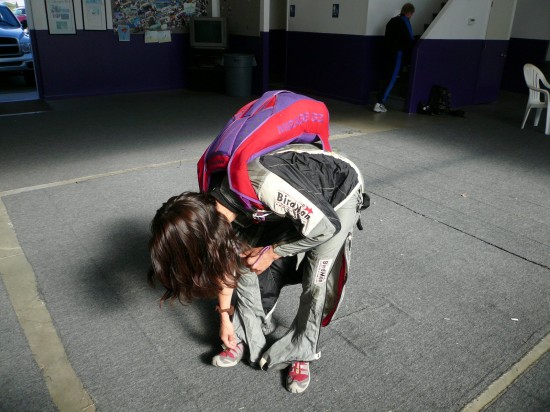
When I started skydiving, my AFF (the training course of the first 7 jumps) cost about $1500. I bought used gear almost immediately, since it cost about $30 to rent a parachute for each skydive. Being a desperately cheap climber, renting gear almost killed me. 😉 My used gear cost $2500, and then I also needed to buy things like a helmet, an altimeter, and make small upgrades to my used gear. That quickly added up to another $300-$500. Once I had my own gear and had passed AFF, I only had to pay for my skydives. Depending on where you jump, a skydive costs about $22-$30 for a jump ticket–for your plane ride up to do a skydive. A good friend gave me an old wingsuit to use, so I saved on that.
I learned to skydive at the Mile Hi dropzone in Longmont, Colorado, because I had good friends who instructed there and was able to stay with other friends in Boulder for the months I spent learning to jump there. For me, it was perfect, though it’s not really a destination DZ where you can camp and hang out. A lot of jumpers seem to like the drop zone in Davis, California, as a place to go through AFF. Eloy, Arizona, is also a huge skydiving destination, and you can even camp there. Zephyr Hills in Florida is another major skydiving destination. Lodi, California, is cheaper than any place in the country ($15 a skydive), but I would very much not recommend learning to jump there, as it’s pretty much every man for himself and you have to be thinking more about survival than learning when you jump there. It’s a great place to rack up cheap jumps, once you have some experience and can look out for yourself. Now that I live in Moab, aside of Skydive Moab, which is a pretty small yet wonderful Cessna operation, I absolutely love jumping in Tooele, near Salt Lake City. It is definitely one of my favorite drop zones.
Most people recommend doing at least 200 skydives before you start to think about base jumping. Seriously, 500 would be the best. 100, for an experienced, hardcore athlete of a different discipline, is the bare minimum, and is still not really enough.
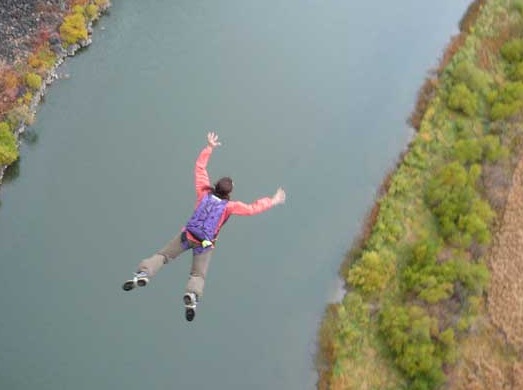
To start base jumping, the best thing to do is to sign up for a first base jump course with Apex Base. They take you to a bridge in Idaho, and teach you how to pack a base canopy and how to safely jump from a bridge. Those courses cost between $1200-$1500. Base gear costs about $2000 or more for a rig, and then you need a helmet and body armor.
You should also buy a SPOT device and the helicopter insurance, and also make sure your health insurance does not have any sneaky exclusions (I used to have Blue Cross Blue Shield of Utah, and unfortunately mine did–they excluded anything involving parachutes and non-commercial aircraft. Now I have Altius).
The Cave of the Swallows in Mexico is currently closed to base jumping, because hundreds of swallows make their home inside the cave, and go flying en masse in and out of the opening of the cave at certain hours of the day, and so they should not be disturbed. This is a very reasonable closure which should be respected.
I hope this information helps. I hope also that it inspires people to think hard about tax dollars and the rights of outdoors people to recreate on public lands in America’s National Parks, and possibly to even take action against the unjustified discrimination against base jumping in these areas.
Good luck!
xxSteph








[…] and also a center for skydiving. You know, Quebeckers get stuff done! Please check out this post to answer all your questions about how to start jumping. I recommend that you start skydiving at […]
Very informative and thought out writeup, Steph.
Good job!
Cheers, Ammon
hey, thanks Ammon!! xxS
If you were the two “dudes” from Boulder base jumping into Mineral Bottom on May 7th and hitched a ride out with a couple in a blue truck, you left something of value in our vehicle.
Identify it and we’ll make arrangements to mail it to you.
ktt
Thanks for being such good samaritans….twice!
thank you for being so hot steph. i really appreciate that
Thanks for the information Steph!.. I am from Durango, CO and my dream is to ski base. I want to start skydiving in Moab. How expensive would it cost to get the recommended ~500 jumps in?
In Moab, the place to learn is Skydive Moab. If you want to bang out jumps for as little $ as possible, go to Lodi, California.